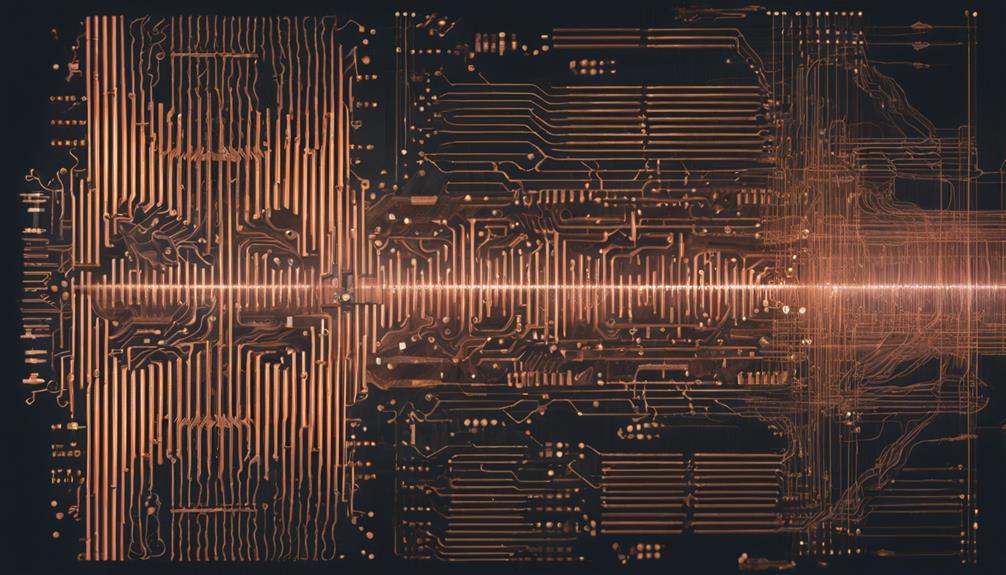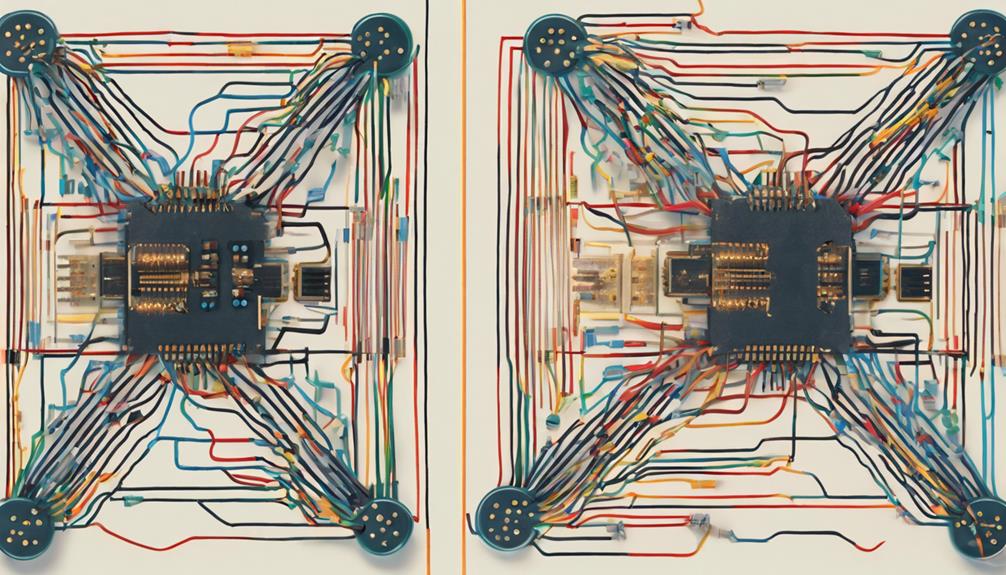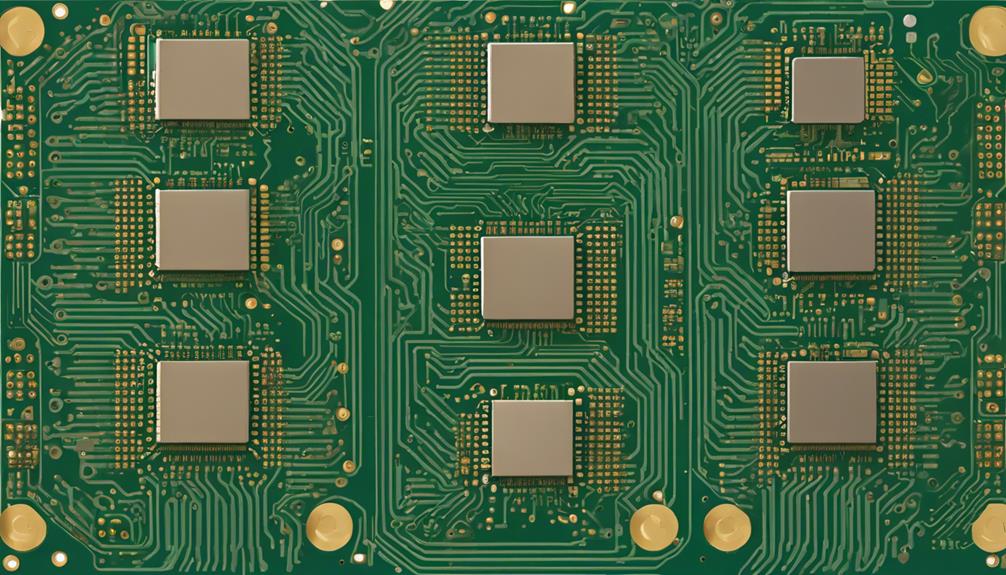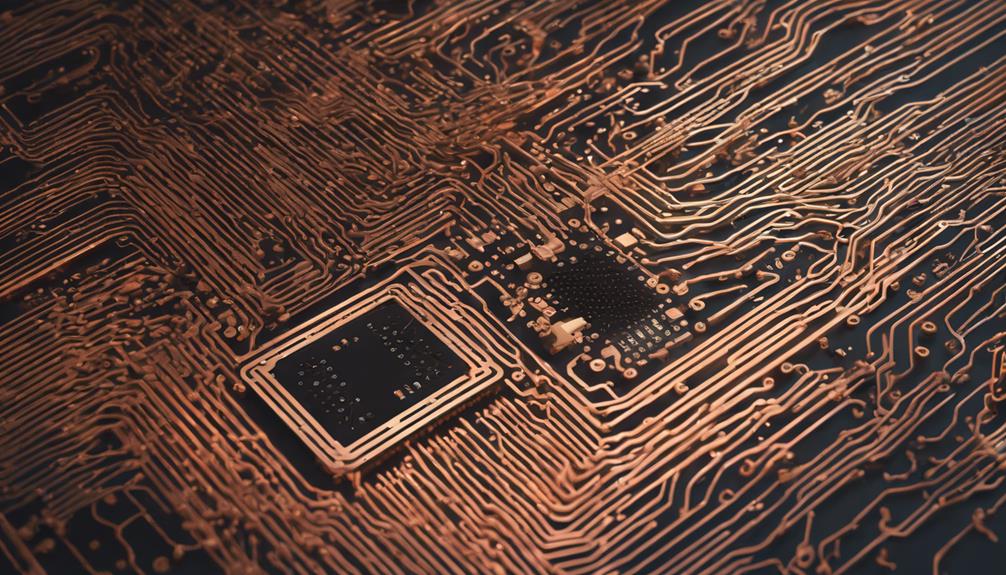High-speed circuit design necessitates adherence to essential design rule checks to guarantee signal integrity and peak performance. Seven critical checks include parallel segment constraints, length constraints for timing, matched lengths for synchronization, daisy chain stub length limits, via placement under SMD components, maximum via count and stub length, and optimizing return paths for signals. These checks prevent unwanted coupling, signal degradation, and timing issues, ensuring reliable high-speed circuit operation. By applying these fundamental principles, designers can mitigate potential pitfalls and ensure their high-speed circuits meet required standards, paving the way for peak performance and reliable functionality.
Key Takeaways
- Implement parallel segment constraints to maintain signal integrity and prevent unwanted coupling and interference.
- Enforce length constraints for timing to regulate propagation delay and prevent timing issues.
- Ensure matched lengths for synchronization to guarantee synchronized signal transmission and prevent timing errors.
- Limit daisy chain stub lengths to prevent signal degradation and maintain signal integrity.
- Manage return paths effectively to reduce electromagnetic interference and ensure reliable circuit operation.
Parallel Segment Constraints
In high-speed circuit designs, parallel segment constraints play a critical role in maintaining signal integrity by specifying the minimum distance required between parallel track segments. This constraint is essential in preventing unwanted coupling and interference between adjacent tracks, ensuring precise routing and spacing for critical signal paths.
By defining parallel segment constraints, designers can enforce precise spacing and layer checking, thereby maintaining signal integrity in high-speed circuits.
In PCB design, parallel segment constraints are a vital aspect of design rule checks (DRC). By setting specific constraints for layer checking and parallel gap, designers can guarantee that their high-speed circuit design meets the required signal integrity standards. These constraints can be tailored to exclude routed differential pair nets, providing an additional layer of precision in the design process.
Length Constraints for Timing

Length constraints for timing play a critical role in high-speed circuit design, as they regulate the propagation delay between components by setting precise limits on signal trace lengths to prevent timing issues and guarantee synchronous signal transmission. By enforcing these constraints, designers can confirm signal integrity and prevent timing errors that can compromise the performance of high-speed circuits.
To achieve this, designers set minimum and maximum length limits for signal traces, ensuring that signal propagation delay is within specified timing requirements. This precise control over signal trace lengths enables synchronous signal transmission, reducing the risk of timing errors and signal skew. Automated tools facilitate the enforcement of length constraints, minimizing manual errors and ensuring precise timing control.
Matched Lengths for Synchronization

To guarantee synchronized signal transmission in high-speed circuits, matched lengths are essential. They ensure that signals arrive simultaneously, preventing timing errors and signal skew. In high-speed designs, matched lengths are critical for maintaining signal integrity and reducing skew.
By setting reference lengths and tolerances, designers can guarantee that signals are transmitted with minimal signal reflections and timing errors. Compliance with matched length rules is essential for differential pairs and signal buses, where signal integrity is paramount. In these critical applications, matched lengths prevent signal timing issues and ensure that signals arrive at the same time, maintaining synchronization.
Daisy Chain Stub Length Limits

Daisy chain topologies, commonly employed in high-speed circuits, require meticulous stub length management to prevent signal degradation and guarantee reliable signal propagation. In high-speed circuits, daisy chain stub length limits are essential for maintaining signal integrity. The daisy chain stub length rule sets a maximum allowable stub length to prevent signal degradation and reflections, ensuring efficient signal transmission. By adhering to these limits, high-speed circuit designs can achieve peak performance and accuracy.
In PCB design tools, the rule definition specifies the maximum stub length for efficient signal transmission. This guarantees that signal integrity is maintained, and reflections are minimized. By limiting the length of stubs in daisy chain topologies, signal degradation is prevented, and reliable signal propagation is guaranteed. As a result, high-speed circuit designs can operate at their best potential, delivering enhanced performance and accuracy.
Via Placement Under SMD Components

In high-speed circuit designs, strategically placing vias under surface-mount devices (SMD) components is crucial for optimizing routing space, enhancing signal integrity, and guaranteeing reliable PCB functionality. Via placement under SMD components plays a critical role in preventing electrical shorts or signal interference, which can impact the performance of high-speed circuits. Proper via placement guarantees efficient thermal management and reliable PCB functionality. Designers must adhere to guidelines for via size, pitch, and clearance to avoid manufacturing issues and performance degradation.
In high-speed design, via placement under SMD components impacts the signal return path, trace width, and via stub length. A well-designed via placement strategy ensures that high-speed signals are routed efficiently, minimizing signal degradation and crosstalk. Differential pairs, for instance, require careful via placement to maintain signal integrity.
Design Rule Checking (DRC) tools can help identify potential issues with via placement under SMD components, ensuring that high-speed circuits meet performance and reliability requirements. By following established guidelines and best practices, designers can make sure that via placement under SMD components does not compromise the performance of high-speed circuits.
Maximum Via Count and Stub Length

By limiting the number of vias in a signal path, designers can greatly reduce impedance and signal degradation, thereby guaranteeing high-speed signal performance. The Maximum Via Count rule is an essential design rule check that enforces this limitation, ensuring signal integrity in high-speed circuits. Adhering to this rule is vital to prevent signal reflections and degradation, which can compromise the performance of high-speed circuits.
In addition to controlling the via count, the Stub Length rule is another critical design rule check that sets constraints on the length of stubs in a signal path. By minimizing stub length, designers can reduce signal reflections and ensure impedance control, thereby maintaining signal quality in high-speed circuits.
Properly managing via count and stub length is crucial for maintaining signal integrity and ensuring compliance with design specifications. By incorporating these design rule checks into their workflow, designers can ensure that their high-speed circuits meet the required performance standards, thereby guaranteeing reliable and efficient operation.
Optimizing Return Paths for Signals

When optimizing return paths for signals in high-speed circuits, careful consideration must be given to signal path geometry to minimize loop area and reduce noise.
Effective return path management is essential to ensuring a continuous and low impedance path for return currents, thereby maintaining signal integrity.
Signal Path Geometry
Optimizing return paths for signals is essential in high-speed circuit design, as it enables the reduction of electromagnetic interference and guarantees signal integrity. Signal path geometry plays a pivotal role in achieving this optimization.
By designing return paths that mirror the signal path, designers can provide a low-impedance path for return currents, minimizing signal degradation and ensuring signal integrity in high-speed circuits. Maintaining a consistent return path is paramount to reduce signal reflections and crosstalk in high-speed designs.
Additionally, routing signal paths close to their return paths reduces loop inductance, ultimately improving signal quality in high-speed circuits. A well-designed signal path geometry is critical to mitigating electromagnetic interference, ensuring that high-speed circuits operate reliably and efficiently.
Return Path Management
Effective return path management is essential in high-speed circuit design, as it provides a low-impedance path for signal return currents, thereby reducing electromagnetic interference and guaranteeing signal integrity. Optimizing return paths involves maximizing a continuous and low-inductance return path for high-speed signals, which is key for maintaining signal integrity.
Ground planes play a significant role in providing an effective return path for signal currents, allowing them to flow back to the source with minimal impedance. Violations in return path management can lead to signal distortion and performance degradation in high-speed circuits.
By ensuring a low-impedance return path, designers can reduce electromagnetic interference and crosstalk, thereby preserving signal integrity. Proper return path management is crucial to prevent signal degradation and guarantee reliable circuit operation.
In high-speed circuit design, attention to return path management is essential to guarantee optimal performance and minimize the risk of signal integrity issues.
Frequently Asked Questions
What Are the Considerations for High-Speed Design?
When designing high-speed circuits, important considerations include:
- Controlled impedance routing
- Signal integrity management
- Minimizing crosstalk to guarantee peak performance
Proper component placement, layer stackup design, and impedance control are essential. Additionally, differential pair routing, signal path length matching, and avoiding parallel routing of high-speed lines are critical.
Careful via placement and minimizing inductance also play significant roles in maintaining signal integrity.
What Is Crucial for High-Speed Design?
Did you know that high-speed circuits operating above 1 GHz can experience up to 50% signal degradation due to poor design?
For high-speed design, it is important to guarantee a clear return path on the reference plane, minimize vias, and implement proper stackup design with multiple ground plane layers.
These considerations are essential to maintain signal integrity and prevent distortion in high-speed circuits, ultimately ensuring reliable and efficient performance.
What Is the 3h Rule in PCB Design?
In PCB design, the 3h Rule stipulates that the distance between parallel traces should be at least three times the height of the dielectric material between them.
This fundamental guideline helps mitigate crosstalk and signal interference, guaranteeing signal integrity and reducing electromagnetic interference.
What Are Basic Checks for RF Design in Pcb?
In the domain of RF design, a delicate balance of signal integrity and electromagnetic harmony unfolds.
When crafting RF designs in PCBs, fundamental checks are essential. These include:
- Verifying controlled impedance traces to minimize signal reflections
- Optimizing transmission line routing
- Maintaining consistent trace widths
Additionally, impedance matching techniques and proper grounding methods are vital to guarantee peak performance in high-frequency applications.


